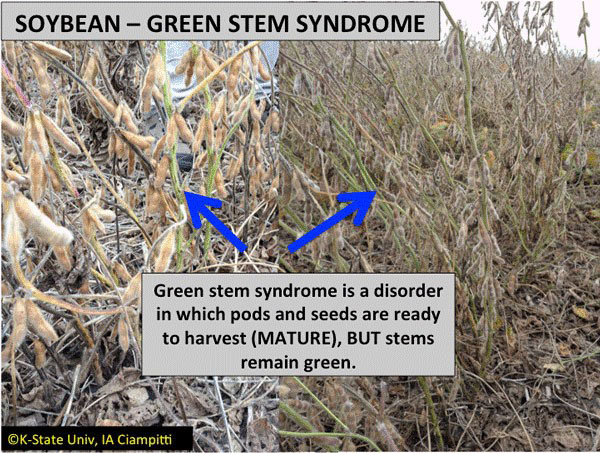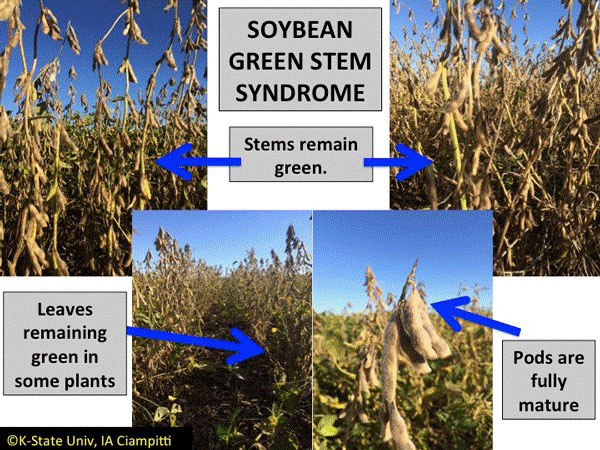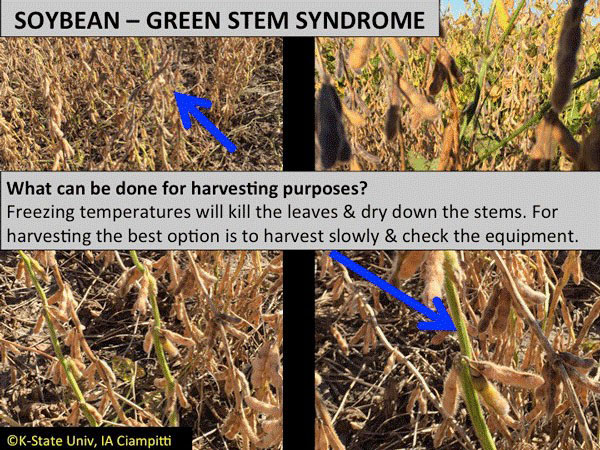Soybean harvest is well underway in Kansas. Complicating harvest, there are reports in multiple areas of “green stem” syndrome. Green stem syndrome in soybeans is a condition where the stem remains green while the seeds are mature and ready to harvest. Some fields throughout the state may have brown pods but green stems (Figures 1, 2, and 3). A hard freeze will kill the leaves and stems, but it may still take a while for the leaves to drop if they are still green.

Figure 1. Green stems and brown pods (indicating mature seeds) characterize green stem syndrome in soybeans. Infographic developed by I. Ciampitti for K-State Research and Extension.

Figure 2. Green stem syndrome in soybeans. Infographic developed by I. Ciampitti for K-State Research and Extension.
What causes of green stem syndrome?
It is most likely due to a combination of early-season stress, low pod counts, and improved late-season growing conditions (i.e., timely rains).
In a “normal” growing season, soybeans will accumulate carbohydrates and proteins in the leaves and stems until seeds begin to form (R5). The leaves provide the photosynthates (food) needed by the newly formed seeds as they begin to fill. The need for photosynthates will eventually exceed what the leaves can provide through photosynthesis as seeds increase in size. As this occurs, the plants move carbohydrates and nutrients from the leaves and stems into the seeds, often called “cannibalization” of the vegetative tissue (rapid senescence and defoliation), but it is a normal process. This eventually causes leaves to turn yellow and drop, and stems to turn brown and die.
When the seed number is low due to abiotic or biotic stressors, the demand for photosynthates produced by leaves and stems lowers. If demand is low enough, the leaves and stems are never “cannibalized” for their carbohydrates and nutrients, and the leaves and stems will remain green longer than normal, even up through the beans’ physiological maturity. Late-season rainfall can exacerbate the problem by keeping the plants alive after the seeds have dried out. It will take either a frost or a chemical desiccant to kill the leaves and stems in this situation. If the leaves are still green and intact when the pods have turned brown and reached 13-14% moisture, it is usually an indication of mid-season stress around flowering/pod set, and low yield potential – at least relative to the amount of foliage produced.

Figure 3. Green stem syndrome in soybeans and suggested harvesting operations. Infographic developed by I. Ciampitti for K-State Research and Extension.
Harvest Timing and Management
Soybeans with green stems can be harvested as soon as seed moisture is low enough, even if some leaves remain. In most cases, harvesting sooner rather than later helps reduce losses from pod shatter and seed weathering.
Harvesting green-stemmed plants can be a slow and messy process. To minimize plugging and header losses:
- Keep harvest equipment sharp and well-maintained.
- Reduce ground speed to handle tough stems.
- Expect more residue buildup if leaves are still attached.
If a freeze has not yet occurred, chemical desiccants can be used to speed leaf and stem dry down, but this option is most useful when an early harvest is planned or frost is not imminent.
As always, ensure that you time your harvest to achieve the optimum seed moisture content, thereby maximizing the final grain volume for sale.
More information on soybean dry down rate can be found in this eUpdate article from September 18, 2025: https://eupdate.agronomy.ksu.edu/article/soybean-seed-filling-and-dry-down-rate-before-harvest-664-4
Tina Sullivan, Northeast Area Agronomist
tsullivan@ksu.edu
Tags: green stem soybeans harvest